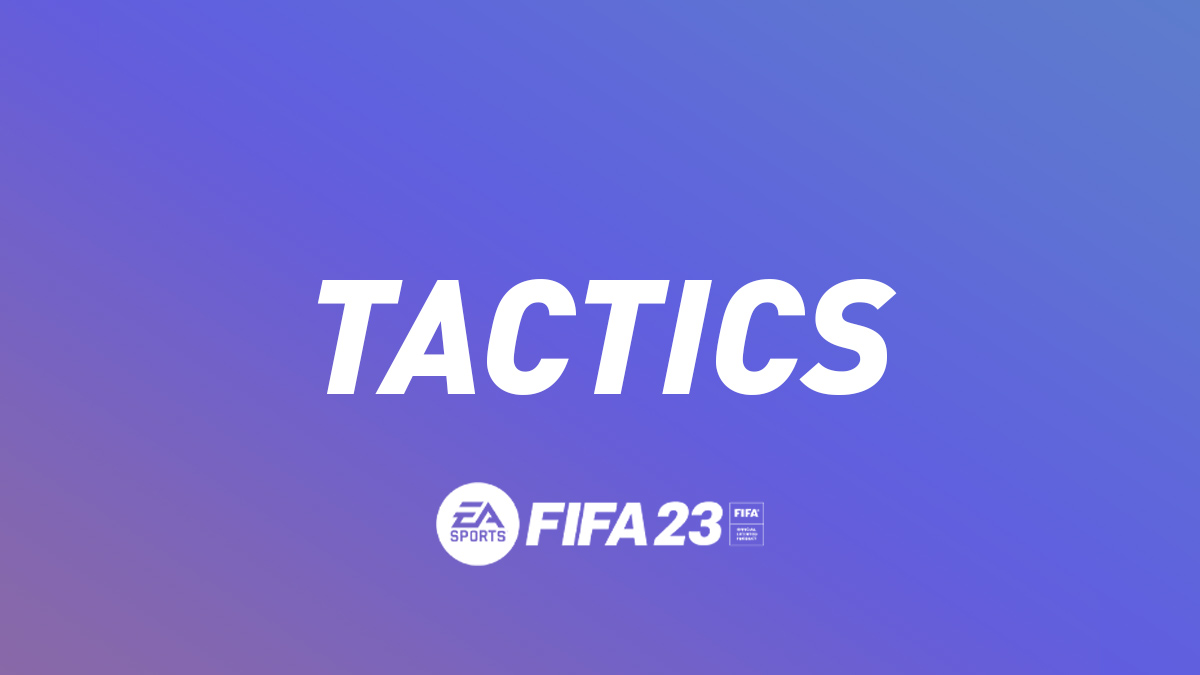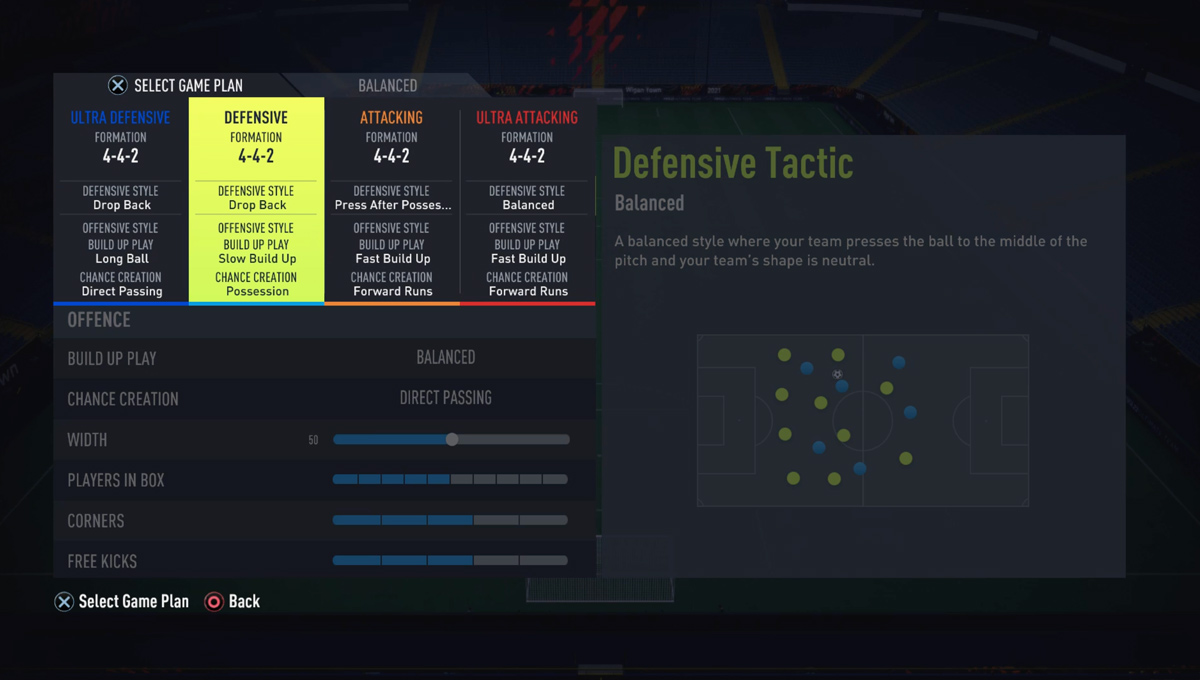
Custom tactics and game plans in FIFA 23 will allow you to alter your tactics before and during matches. Your squad will implement your strategy in FIFA 23 in an evident manner so that you can see how it works on the field.
Setting dynamic tactics will help your team to do a better job on the pitch. The tactics are available under Team Management screen in FIFA 23 before going play a match. In FIFA 23 Ultimate Team, you can also access the custom tactics from the Squad Actions menu > Custom Tactics.
Your tactics & strategies can be customised based on your Defence and Offences. You can customise your tactic style in each mode by adjusting the balance, forms, and scenarios. The settings and details for each mode, as well as their breakdowns, are listed below.
Tactics
DEFENCE
Defensive tactic setting will help you define your team’s playing style in terms of defence. Below is the list of setting to set your defensive style:
Defensive Style
- Balanced – Your team presses the ball to the centre of the pitch in this balanced method, and your team’s shape is neutral.
- Pressure on Heavy Touch – This tactic will allow your squad to maintain their shape until the moment to apply pressure presents itself. When the opponent takes a hard touch, it’s a loose ball, or controlling a tough pass in front of their own goal, pressure is applied.
- Pressure After Possession Loss – After your team loses possession of the ball, your teammates will press the ball for about 7 seconds using this method. This may effect player weariness, and if you don’t win it back during this period, your players may be out of position.
- Constant Pressure – This tactic style will put a lot of pressure on the opponents on the field. This strategy may expose your squad to vulnerability as your players become more exhausted and are pushed out of position.
- Drop Back – A stratagem that keeps your team together while giving your opponents more possession. When you win the ball, your forwards will likely remain passive, and you may find yourself with fewer attacking alternatives.
Width
The width of your team has an impact on how much it shifts to the ball side. Your team will cover the centre position with the narrower width, while the broader width will cover the wings.
- 1 to 35 [Narrow] – This will shape your defensive team to be narrow and cover central positions, making it more difficult for your opponent to play through the middle of your team; however, bear in mind that you’ll leave more space out wide for the opposition wingers. Your defence will be compact, with players pinching in on the far side to cover teammates and provide pressure on the ball side.
- 36 to 69 [Balanced] – This will maintain the shape of your defensive team balanced. Your team will not attempt to defend in a narrow or wide manner. When you don’t have the ball, one-on-one situations may become more regular.
- 70 to 100 [Wide] – This change will keep your defensive team’s shape wide enough to cover the wings, but it may leave openings in the middle. The team will use less pinches. On the far side, players will mark opponents closely, forgoing cover in favour of making it tough for the opposition to pull them out of shape.
Depth
Your team’s depth determines how far or high you should travel to put pressure on your opponent. The deeper the depth, the less space behind the back line is available, while the higher the depth, the more pressure is applied to possession teams.
- 1 to 35 [Deep] – This will keep your defensive team’s shape deep, allowing long balls and quick strikers to make runs in behind your back line. When you play deep, you give the opposition more opportunities for long shots or possession. In exchange for obtaining numbers behind the ball, the team will drop back and allow the opposition into their own half.
- 36 to 69 [Balanced] – This setting will aid in the balanced formation of your defensive team, allowing you to maintain your team in the middle of the pitch in order to win the midfield battle.
- 70 to 100 [High] – This will change the shape of your defensive unit to help put pressure on possession teams. Your back line will be high, leaving you open to long balls from behind.
OFFENCE
Adjusting your offensive tactic will assist you identify your team’s defensive playing style. The following is a list of options for customising your attacking style:
Build Up Play
- Balanced – This tactic is utilised by a well-balanced team that keeps its shape. Players will assist and make runs when they believe it is appropriate.
- Slow Build Up – Rather of embarking on forward runs, players will focus on supporting each other. The squad is patiently constructing play, frequently throwing the ball around in defence and with players passing backwards on a regular basis. This strategy improves a short passing game, but it takes longer for your team to build up.
- Fast Build Up – The Fast Build Up method encourages players to move forward for a quicker build up, but if you lose possession of the ball, you may be vulnerable to a counterattack.
- Long Ball – Your team will make runs for long balls into space behind the opposing back line, or up to a target man. Strikers who are fast with a good attacking positioning attribute are the best at this tactic.
- Possession – Players will support more, rather than going on forward runs. The team is patient building play, often passing the ball around in defence with players regularly passing backwards. This tactic strengthens a short passing game, but will cause your team to take longer to build up.
Chance Creation
- Balanced – Balanced tactic is used for a balanced team that maintains its formation,. Player will support and make runs when they think it’s the right time to do so.
- Possession – Players will support more, rather than going on forward runs. The team is patient building play, often passing the ball around in defence with players regularly passing backwards. This tactic strengthens a short passing game, but will cause your team to take longer to build up.
- Forward Runs – Forward Runs tactic will push players forward deep into attacking areas, but if you lose possession of the ball, you could find yourself open to a counterattack.
- Direct Passing – Once the team enters the attacking zone with possession players will create chances by making runs for passes into space behind the opposing back line. Strikers who are fast with a good attacking positioning attribute are the best at this tactic.
Width
The width of your team which affects how much the team will shift to the ball side. The narrower width will keep your team to cover central position while the wider width will cover the wings.
- 1 to 35 [Narrow] – This will change the structure of your offensive team such that there are more men in the middle of the pitch for short passing options. When you lose possession, the wings will open.
- 36 to 69 [Balanced] – To provide you more attacking alternatives, adjust your offensive squad structure to be balanced for generic positioning.
- 70 to 100 [Wide] – To push your wide players to the sidelines, change the structure of your offensive team. You’ll have more passing choices in the wide areas of the pitch, but fewer in the middle.
Players in Box
When in the crossing zone, you will have some players making runs into the penalty area if it’s the right time to make the run.
- 1 to 3 / 10 [Low] – Adjust your team’s composition in the crossing zone to have fewer players in the box for a more patient attacking strategy. Your players will rarely make forward runs for crossing situations and will instead stay outside the box.
- 4 to 7 / 10 [Balanced] – When you’re in the crossing zone, some players will make sprints into the penalty area if the timing is good.
- 8 to 10 / 10 [High] – When your players are in the crossing zone, tell them to make a bunch of runs into the box. This may be beneficial in terms of getting numbers into the box, but it may leave you open to a counterattack.
Corners
The amount of players in opposition’s penalty are during corner kicks.
- 1 to 3 / 5 [Low] – For a more defensive stance, keep a small number of players in the opposition’s penalty area on corners.
- 4 / 5 [Normal] – Have a normal amount of players in the opposition’s penalty area during corners.
- 5 / 5 [High] – For a more offensive tactic, place a large number of players in the opposition’s penalty area on corners.
Free Kicks
The amount of players in opposition’s penalty are during free kicks.
- 1 to 3 / 5 [Low] – Have a low amount of players in the opposition’s penalty area during free kicks for a more defensive approach.
- 4 / 5 [Normal] – During free kicks, have a typical number of players in the opposition’s penalty area.
- 5 / 5 [High] – For a more offensive tactic, place a large number of players in the opposition’s penalty area on free kicks.

Game Plans
You can also edit your Game Plans before and during a game. For your matches, you can choose from five different game plans. You can change your game plan on the fly mid-match using your gamepad D-Pad Left/Right buttons.
To edit your Game Plans in FIFA 23, got to the Team Management menu – Available under Squad Actions menu (L2/LT) in FUT Squad screen, select Custom Tactics, then press L2/LT to navigate to the Edit Game Plans menu.
Each Game Plan will allow you to give a formation and a custom tactic set for defensive and offensive playing styles to your game plan, allowing you to swap between them simply before and during game play. In FIFA 23, the following are the game plan tactics:
- Ultra Defensive – In this game plan, you might implement a tighter defensive strategy to make your squad more defensive.
- Defensive – Using this plan, you can include a defensive technique to encourage your squad to remain defensive.
- Attacking – You can set a attacking tactic in this game plan to provide more opportunities for you to score.
- Ultra Attacking – You might use a technique to encourage your players to attack and score goals as quickly as possible.
To switch your tactics and game plans during a match, use your left and right directional buttons on your gamepad. Left D-Pad button will change your game plan to Defensive and Ultra Defensive, while right D-Pad button will change to attacking plans.
I can’t change my tactics from balance to attack